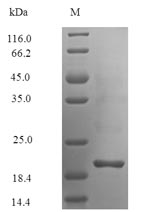Recombinant Androctonus australis Alpha-mammal toxin AaH2 is produced in E. coli and includes the full length of the mature protein, covering amino acids 20 through 83. This product comes with an N-terminal 6xHis-SUMO tag, which streamlines purification and detection processes. The protein achieves high purity levels exceeding 90% as confirmed by SDS-PAGE, providing what appears to be a dependable reagent for research work.
Alpha-mammal toxin AaH2 from Androctonus australis represents a crucial element in studying the neurotoxic effects of scorpion venom. This toxin targets voltage-gated sodium channels - structures that are essential for nerve impulse transmission. Research on this protein may help advance our understanding of channel physiology and could lead to the development of therapeutic agents for conditions involving ion channel dysfunction.
Potential Applications
Note: The applications listed below are based on what we know about this protein's biological functions, published research, and experience from experts in the field. However, we haven't fully tested all of these applications ourselves yet. We'd recommend running some preliminary tests first to make sure they work for your specific research goals.
1. Ion Channel Binding and Interaction Studies
This recombinant scorpion toxin works well in radioligand binding assays or surface plasmon resonance experiments when studying its interaction with various ion channels. Sodium and potassium channels appear to be particularly common targets of scorpion toxins. The N-terminal His-SUMO tag makes purification easier and allows for immobilization on sensor surfaces during real-time binding kinetics analysis. Scientists can examine binding specificity, affinity constants, and competitive binding with other channel modulators. These studies may contribute to understanding the molecular basis of toxin-channel interactions and structure-activity relationships.
2. Antibody Development and Immunoassay Applications
The recombinant AaH2 toxin functions as an effective immunogen and coating antigen for developing specific antibodies against Androctonus australis venom components. High purity levels (>90%) and consistent production from E. coli expression help ensure reproducible immunization protocols and standardized ELISA development. The His-SUMO tag can be used for oriented immobilization in immunoassays, which might improve antibody binding accessibility. These antibodies could prove valuable as research tools for venom composition analysis and cross-reactivity studies with related scorpion species.
3. Protein-Protein Interaction Mapping
The His-tagged recombinant toxin works in pull-down assays to identify and characterize protein targets in membrane preparations or cell lysates. The SUMO tag appears to provide additional stability and solubility, making it suitable for co-immunoprecipitation experiments with membrane protein complexes. Researchers can use this protein to map interaction networks and identify novel binding partners beyond traditional ion channel targets. Mass spectrometry analysis of pulled-down complexes is likely to reveal potential auxiliary proteins or regulatory subunits involved in toxin binding.
4. Structural and Biophysical Characterization Studies
This recombinant toxin preparation shows promise for detailed structural analysis using techniques such as NMR spectroscopy, X-ray crystallography, or cryo-electron microscopy. High purity and homogeneous preparation from E. coli expression provides consistent material for biophysical studies including circular dichroism spectroscopy, dynamic light scattering, and thermal stability analysis. The defined expression region (20-83aa) representing the mature protein ensures structural studies focus on the biologically relevant domain. These investigations may advance understanding of scorpion toxin fold architecture and stability properties, though results can vary depending on experimental conditions and protein behavior in different environments.






